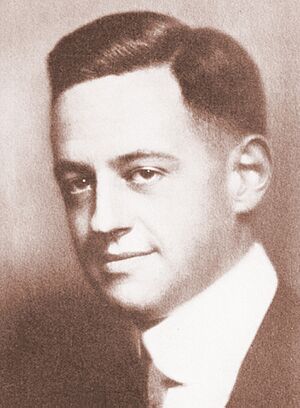Eric Fisher Wood facts for kids
Eric Fisher Wood Sr. (1888–1962) was an American engineer and a general in the Pennsylvania Army National Guard. He also helped start The American Legion, a large organization for military veterans.
Contents
Life and Achievements
Early Life and Education
Eric Fisher Wood was born in New York City in 1888. His mother was Frances Fisher Wood and his father was Dr. William Benjamin Wood.
As a young boy, Eric went to private schools. Later, he studied at Yale University in New Haven, Connecticut. He earned degrees in Economics and English, and a PhD in civil engineering. He also studied architecture at Columbia University in New York City and at the famous École des Beaux-Arts in Paris, France.
World War I Activities
When World War I began, Eric Fisher Wood was in Paris. He volunteered to help at the American Embassy there. He joined the staff to manage the huge amount of work caused by the war. Later, he joined the American Ambulance Corps for a few months. He wrote about his experiences in Europe in a book called The Note-book of an Attaché: Seven Months in the War Zone, published in 1915.
After returning to the United States, Wood became a leader in the National Security League. This group wanted to make America's military stronger because of the war in Europe. From 1915 to 1916, he was also part of the Plattsburgh Training Camp Executive Committee. During this time, he wrote another book about military readiness, called The Writing on the Wall.
In 1917, Wood went back to Europe. He served as a major in the British Army. He was wounded in battle at Arras on April 9, 1917.
Later in 1917, after America joined the war, Wood became a major in the U.S. Army. He worked as an assistant chief of staff for the 88th Infantry Division. He was wounded again, this time by poison gas, during the Meuse-Argonne Offensive in the fall of that year. By the end of the war in November 1918, he had become a lieutenant colonel.
Starting The American Legion
On February 15, 1919, General John J. Pershing asked Wood and 19 other officers to join a special committee. This committee, led by Theodore Roosevelt Jr., was tasked with finding ways to improve the spirits of the soldiers. They suggested things like more sports, fun activities, and longer breaks.
However, Lieutenant Colonel Roosevelt had another secret plan. That evening, the group met at an officers' club. There, Roosevelt suggested creating a new group for veterans. This idea led to the creation of The American Legion.
A small group of four people, including Roosevelt, was chosen to start this new organization. Roosevelt was to go back to the U.S. and gather support. Wood was put in charge of the European efforts, working with former Ohio Congressman Ralph D. Cole. They set up an office to communicate with military divisions and spread the word to the news.
Eric Fisher Wood was also the first temporary chairman of the April 1919 Paris Caucus of the American Legion. He also served as the secretary for the next two meetings, the St. Louis Caucus and the Minneapolis National Convention, which officially created the organization.
After the Wars
In the 1920s, Wood moved to Pittsburgh, Pennsylvania. There, he became a well-known architect.
He also continued his military service as the commander of the Pennsylvania National Guard.
When World War II started, Wood was called back to active duty. He served throughout the war and became a brigadier general.
During his military career, Wood received many awards. These included the Legion of Merit, the Purple Heart (with an oak leaf for a second award), and the Croix de guerre from France. He also earned 20 ribbons and 10 battle stars.
Later Life and Legacy
Eric Fisher Wood Sr. passed away in 1962. His oldest son, Eric Fisher Wood Jr., had died earlier during World War II at the Battle of the Bulge.
Wood's important papers, including letters, writings, diaries, and photos, are kept at Syracuse University Library in Syracuse, New York.
One of Wood's most famous architectural works is the Harding Tomb in Marion, Ohio. This large, classical structure made of white marble was co-designed by him. It is the memorial for former President Warren G. Harding.
Published Works
Eric Fisher Wood wrote several books and articles, often about military topics and his experiences:
- The Note-book of an Attaché: Seven Months in the War Zone. (1915)
- The Note-Book of an Intelligence Officer. (1917)
- The ROTC Manual: Field Artillery: A Textbook for the Reserve Officers Training Corps: Basic Course. (1934)
- Lectures on Troop Leading and Staff Procedure. (1942)
Images for kids




